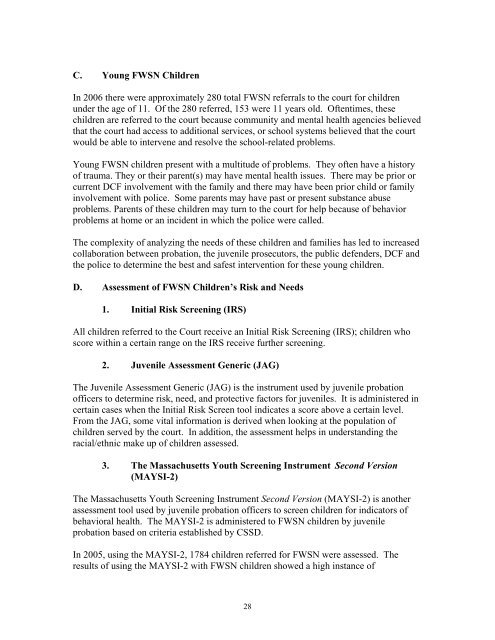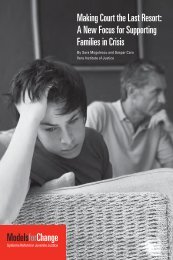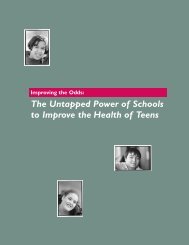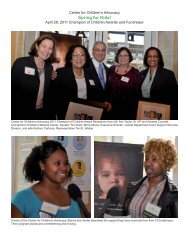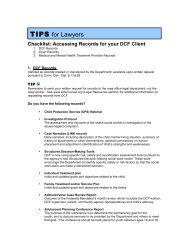FWSN-advisorybd-repo.. - The Connecticut Juvenile Justice Alliance
FWSN-advisorybd-repo.. - The Connecticut Juvenile Justice Alliance
FWSN-advisorybd-repo.. - The Connecticut Juvenile Justice Alliance
Create successful ePaper yourself
Turn your PDF publications into a flip-book with our unique Google optimized e-Paper software.
C. Young <strong>FWSN</strong> Children<br />
In 2006 there were approximately 280 total <strong>FWSN</strong> referrals to the court for children<br />
under the age of 11. Of the 280 referred, 153 were 11 years old. Oftentimes, these<br />
children are referred to the court because community and mental health agencies believed<br />
that the court had access to additional services, or school systems believed that the court<br />
would be able to intervene and resolve the school-related problems.<br />
Young <strong>FWSN</strong> children present with a multitude of problems. <strong>The</strong>y often have a history<br />
of trauma. <strong>The</strong>y or their parent(s) may have mental health issues. <strong>The</strong>re may be prior or<br />
current DCF involvement with the family and there may have been prior child or family<br />
involvement with police. Some parents may have past or present substance abuse<br />
problems. Parents of these children may turn to the court for help because of behavior<br />
problems at home or an incident in which the police were called.<br />
<strong>The</strong> complexity of analyzing the needs of these children and families has led to increased<br />
collaboration between probation, the juvenile prosecutors, the public defenders, DCF and<br />
the police to determine the best and safest intervention for these young children.<br />
D. Assessment of <strong>FWSN</strong> Children’s Risk and Needs<br />
1. Initial Risk Screening (IRS)<br />
All children referred to the Court receive an Initial Risk Screening (IRS); children who<br />
score within a certain range on the IRS receive further screening.<br />
2. <strong>Juvenile</strong> Assessment Generic (JAG)<br />
<strong>The</strong> <strong>Juvenile</strong> Assessment Generic (JAG) is the instrument used by juvenile probation<br />
officers to determine risk, need, and protective factors for juveniles. It is administered in<br />
certain cases when the Initial Risk Screen tool indicates a score above a certain level.<br />
From the JAG, some vital information is derived when looking at the population of<br />
children served by the court. In addition, the assessment helps in understanding the<br />
racial/ethnic make up of children assessed.<br />
3. <strong>The</strong> Massachusetts Youth Screening Instrument Second Version<br />
(MAYSI-2)<br />
<strong>The</strong> Massachusetts Youth Screening Instrument Second Version (MAYSI-2) is another<br />
assessment tool used by juvenile probation officers to screen children for indicators of<br />
behavioral health. <strong>The</strong> MAYSI-2 is administered to <strong>FWSN</strong> children by juvenile<br />
probation based on criteria established by CSSD.<br />
In 2005, using the MAYSI-2, 1784 children referred for <strong>FWSN</strong> were assessed. <strong>The</strong><br />
results of using the MAYSI-2 with <strong>FWSN</strong> children showed a high instance of<br />
28


